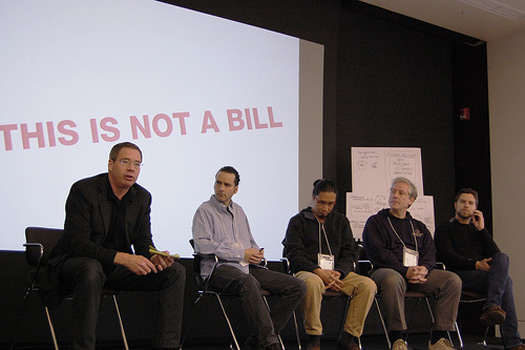
November 23, 2009
Aspen Design Summit Report: CDC and Healthy Aging

Abstract
At the Aspen Design Summit sponsored by AIGA and Winterhouse Institute November 11–14, 2009, the CDC Healthy Aging Project focused on how to enhance the ability of public health entities to determine whether adults 50 and over are “up to date” with a set of recommended health services, and how to broaden the delivery of these services through community programs, information messaging and infrastructure. Separately, the team was asked to think about ways to extend these services to emergency situations.
The team ended up with a comprehensive plan to launch a national campaign called “5 over 50” aimed at encouraging people aged 50 to 64 to be current on a basic set of recommended preventive health measures. Embedded within the campaign were incentives and facilitators to create the appropriate infrastructure to motivate people to take part, and to deliver services in an efficient and convenient way.
Overview of the Problem
The team’s starting point was a set of sobering statistics about the imminent longevity boom in the United States. By 2015, one of every five Americans will be between the ages of 50 and 64. By 2030, the number of Americans 65 and older will more than double to 71 million, comprising roughly 20 percent of the population. A related statistic on the overall health of this age group presented another startling perspective: by the time they are in their mid-sixties, 70 percent of adults will be diagnosed with at least one chronic condition and nearly half will have two or more. And despite national guidelines on recommended preventive services that can help detect diseases in early or treatable stages, or delay their onset — such as breast and colorectal cancer — fewer than 25 percent of adults aged 50 to 64 receive testing. In a presentation to the Summit, the team asked participants if they knew anyone who missed a screening and was later diagnosed with breast cancer, or who didn’t get a flu shot and developed pneumonia. The response was an overwhelming show of hands that reflected how we have all been touched by a health crisis that might easily have been prevented.
Redefining the Goal
The team redefined the Healthy Aging Project’s overall objective to increase the use of preventive services (such as cancer screenings and flu vaccinations) as a way to improve long-term health as this age group advances. Because these prevention measures are repeated — often on an annual basis — rather than being a one-time intervention driven by a specific medical event in a clinical setting, the team decided to focus on everything but the usually short doctor-patient conversation; that is, to look for opportunities outside a clinical setting. Participants agreed to take a community and virtual-community approach that would leverage social mechanisms and technology to get the message out and would establish an infrastructure to deliver it.
The team worked to understand the attitudes of the 50-plus generation. When reaching 50, a watershed age, adults require a package of five services on a regular basis, from flu shots to pap smears. This age group, however, is considered high-risk: while many members are still working, others start to drop out of employee insurance programs and neglect services that incur costs (until they reach 65, when they are eligible for Medicare), leaving gaps in coverage. The CDC members noted that people 50 to 64 years old have so far not been examined closely in clinical prevention programs.
The team discussed the concerns that deter people from receiving preventive services. Cost is the most common theme, followed by fear of the procedure and its outcome — the bad information they might learn. Although people in this age group will seek medical care if they are feeling ill, they are unwilling to spend time and money and to experience discomfort in order to receive bad news. Another barrier is the destination: the fact of having to go somewhere to get the services. Yet there can also be a sense of reward and pride — the recognition by members of this age group that they have accomplished something that their loved ones — and community — want them to do. The team concluded that if obtaining the services were made easier, and the experience became more pleasurable, people would be more willing to go.
A few basic questions emerged: how to motivate people to take care of themselves? What kind of incentives might be provided to encourage them? How to make the services more available and accessible, and what obstacles have to be removed to enable that?
A Model
The team looked at the SPARC (Sickness Prevention Achieved through Regional Collaboration) program started by team member Dr. Doug Shenson and backed by the CDC. SPARC promotes influenza and pneumococcal vaccinations; cancer screening (mammograms, pap tests and colonoscopies); cardiovascular screenings (cholesterol and blood pressure tests) with follow-up as needed. In addition, SPARC was involved in the Vote and Vax initiative, in which people of all ages could receive flu vaccinations at polling places.
It was noted that SPARC became a community resource, which conveyed the idea that public health is about everyone — not just the underserved; it reduced the friction associated with access to preventive services; it planted a flag in the community by allowing local folks to tell those who sought services where to go. Team discussions focused on other places or events that might serve as informational centers, from barber shops to hair salons, football games, gas stations and grocery stores. The conclusion was that you need a hook — such as a quick and easy vaccination — by which you can link people to other services. Another essential component is a “neutral convener,” say, an organization for the aging or a medical society, that maintains an interest in disease prevention but is not directly involved, which can deliver the service and be a community advocate. A neutral convener can also define a geographical area and figure out points of access and how services are communicated, coordinated and delivered.
Field Work
A field trip to a senior center in Aspen, and an informal round-table discussion with four seniors, illuminated some of the prevailing attitudes about preventive care for this age group. When asked about such services, responses ranged from “I do everything” to “I do nothing,” based on a variety of factors, from cost to religious upbringing and outlook on life. All expressed concern about cost and accessibility. Yet the most compelling statement came from a man who had ignored preventive services but was recently found to have a 70-percent clogged artery while being treated for a minor ailment. “I didn’t plan to do it but now I am taking action,” he said, adding, “I want to live longer to see my son have children and to be a grandfather. I am looking forward to the future.” The team also spoke with Nan Sundeen, director of health and human services for Pitkin County, Colorado, who underscored the difficulties of healthcare providers in delivering preventive health services, especially in rural resort areas like Aspen.
An Idea Takes Shape
Several themes emerged at this point, based in part on the interviews with seniors. One was to leverage influencers, such as grandchildren or other loved ones, who might be able to convince their grandparents (by sending them cards on their birthday, for example) to take preventive health measures. This can be a powerful tool.
Another method to encourage greater participation is to use trusted advocates, who could spread the word about preventive services and provide information. The team outlined special events — such as Thanksgiving and birthdays — that would provide occasions to send a message to over-fifities about the five recommended preventive services.
In turn, this led the team to coin the “5 over 50” brand name (“5” describes both the number of basic services over-fifties should seek and the age when children are up to date on their immunizations). The team outlined its goal to double the current number of adults who are current with these services. Possible delivery mechanisms include mobile units, which might visit offices of companies aligned with the program, and social networks, such as Tupperware-party-like gatherings. Rewards for achieving “5 over 50” might be eponymous bracelets (similar to Lance Armstrong’s “Livestrong” wrist band) or loyalty cards.
Next Steps and Action Plan
Team members from CDC’s Healthy Aging department and AARP expressed strong general support for the project. The next step is to prepare an internal marketing playbook for them to take back to officials to test the waters in both organizations for the “5 over 50” brand and its narrative. At the same time, AARP will gather feedback by conducting a survey, using its “Create the Good” civic-engagement feature on its website, based on the questions asked in our senior center visit — as well as the effectiveness of the “5 over 50” brand.
The conversation would then be expanded to a wider circle of possible stakeholders, such as the AMA, insurance companies, national business groups concerned with health issues, Mayo Clinic, Robert Wood Johnson Foundation and the National Association of City and County Health Authorities, among others. A mini-summit of stakeholders would be held to co-design a national demonstration project — a SPARC 2.0 in multiple sites, which would also track and measure outcomes — and outline possible funding sources. Eventually, the team foresees “5 over 50” being adopted as CDC policy and being proposed to Congress for funding as a health priority to be implemented nationally.
Team Members
Moderators: Robert Fabricant, Vice President Creative, Frog Design and Fabio Sergio, Creative Director, Frog Design Milan
Recorder: Ernest Beck, Editorial Director, Aspen Design Summit
Renna Al-Yassini, Design Research & Strategy Consultant; Adjunct Instructor, School of Design, Carnegie Mellon University
Lynda Anderson, Director, Healthy Aging Program, Centers for Disease Control and Prevention
Gaby Brink, Founder and Principal, Tomorrow Partners; Co-Chair, AIGA Center for Sustainable Design
Dan Buchner, Vice President, Organizational Innovation, Continuum
Nicholas LaRusso, Executive Director, Mayo Clinic Center for Innovation
Doug Powell, Principal, Schwartz Powell
Douglas Shenson, Associate Clinical Professor, Yale School of Public Health; Director, Sickness Prevention Achieved through Regional Collaboration
Amy B. Slonim, AARP Liaison, Centers for Disease Control and Prevention
Significant contributions to the writing of this report were made by Ernest Beck and Robert Fabricant.
Documents
A PDF of the briefing book chapter on the CDC Healthy Aging Project is available here.
The original website for the Aspen Design Summit, as well as a list of all participants, is here.
Observed
View all
Observed
By Aspen Editors
Related Posts

Ernest Beck|Event-Aspen
Sustainable Health Enterprises Wins Prestigious Curry Stone Design Prize

Arts + Culture
Aspen Editors|Event-Aspen
Aspen Design Summit: Update 09.25.10

Helen Walters|Event-Aspen
Next: Innovation Tools & Trends Rockefeller Foundation’s Push Toward Design and Innovation

Helen Walters|Event-Aspen
Inside the Design Thinking Process
Recent Posts
A quieter place: Sound designer Eddie Gandelman on composing a future that allows us to hear ourselves think It’s Not Easy Bein’ Green: ‘Wicked’ spells for struggle and solidarity Making Space: Jon M. Chu on Designing Your Own Path Runway modeler: Airport architect Sameedha Mahajan on sending ever-more people skywardRelated Posts

Ernest Beck|Event-Aspen
Sustainable Health Enterprises Wins Prestigious Curry Stone Design Prize

Arts + Culture
Aspen Editors|Event-Aspen
Aspen Design Summit: Update 09.25.10

Helen Walters|Event-Aspen
Next: Innovation Tools & Trends Rockefeller Foundation’s Push Toward Design and Innovation

Helen Walters|Event-Aspen
